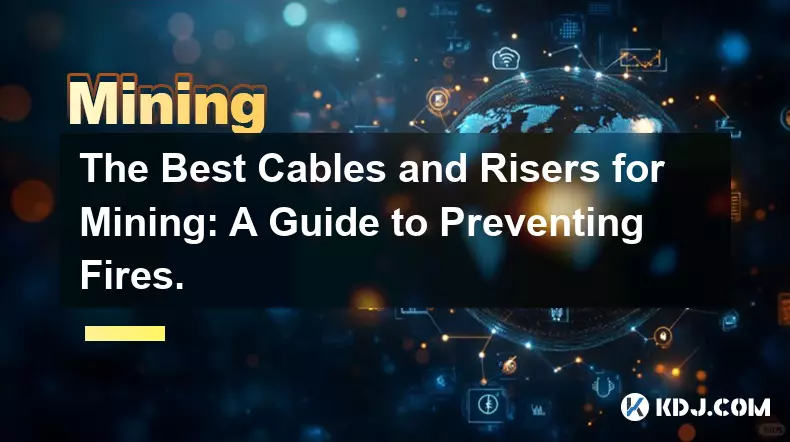-
 bitcoin
bitcoin $102877.190955 USD
1.88% -
 ethereum
ethereum $3430.435064 USD
4.52% -
 tether
tether $0.999264 USD
-0.05% -
 xrp
xrp $2.307310 USD
4.49% -
 bnb
bnb $987.740692 USD
3.82% -
 solana
solana $161.947760 USD
3.97% -
 usd-coin
usd-coin $0.999712 USD
-0.05% -
 tron
tron $0.292810 USD
2.93% -
 dogecoin
dogecoin $0.179738 USD
10.70% -
 cardano
cardano $0.580716 USD
8.75% -
 hyperliquid
hyperliquid $42.463448 USD
8.40% -
 chainlink
chainlink $15.763437 USD
7.05% -
 zcash
zcash $649.595636 USD
17.21% -
 bitcoin-cash
bitcoin-cash $511.610261 USD
7.19% -
 stellar
stellar $0.292537 USD
7.91%
The Best Cables and Risers for Mining: A Guide to Preventing Fires.
Using high-quality, pure copper cables and powered PCIe risers ensures stable, safe operation in multi-GPU mining rigs, reducing fire risks and improving efficiency.
Nov 05, 2025 at 10:40 am

The Importance of Quality Cables in Cryptocurrency Mining
1. Reliable power delivery is critical when operating multiple GPUs in a mining rig, and substandard cables can overheat, leading to potential fire hazards. Using cables rated for the correct amperage ensures stable current flow without excessive resistance.
2. Copper purity plays a major role in conductivity; cables with low-grade or copper-clad aluminum (CCA) wiring increase resistance and generate more heat under load. Always opt for pure oxygen-free copper (OFC) cables designed specifically for high-power applications like GPU mining.
3. Thicker gauge wires, such as 16AWG or 18AWG, are better suited for sustained high-current draw from graphics cards. Thin or undersized cables not only reduce efficiency but also pose serious safety risks during continuous operation.
4. Modular PSU connectors should match the cable specifications exactly. Mismatched or improvised connections—like using SATA to PCIe adapters—can overload circuits and cause connector melting.
5. Regular inspection of cables for fraying, discoloration, or warmth after extended use helps identify early signs of failure. Replacing worn cables before they fail prevents catastrophic outcomes.
Choosing Safe and Efficient PCIe Risers
1. Not all PCIe risers are created equal; many budget models use poor PCB layouts and inadequate shielding, increasing electromagnetic interference and signal degradation. Select risers with USB 3.0 signaling and built-in EMI filters to maintain stable data transfer between the motherboard and GPU.
2. Powered risers that draw auxiliary power directly from the PSU via SATA or Molex connectors reduce strain on the motherboard’s PCIe slot. This design minimizes voltage drops and improves overall system stability.
3. Look for risers with overcurrent and short-circuit protection. These safety features help prevent cascading failures if one component draws too much power or experiences a fault.
4. Gold-plated contacts resist oxidation and maintain strong connectivity over time. Oxidized or corroded connectors increase resistance, which can lead to localized heating at the interface point.
5. Avoid daisy-chaining multiple risers off a single PCIe slot unless your motherboard and PSU are explicitly designed for such configurations. Overloading lanes or power rails increases instability and risk.
Maintaining a Fire-Safe Mining Environment
1. Proper ventilation around cables and risers prevents heat buildup. Enclosed spaces trap warm air, accelerating insulation breakdown and solder joint fatigue on circuit boards.
2. Use cable management techniques to avoid sharp bends or pinching, especially near connectors. Physical stress can damage internal conductors and create hotspots.
3. Install mining rigs on non-flammable surfaces such as metal racks or stone flooring. Wooden tables or carpeted areas increase fire propagation risk if a component ignites.
4. Incorporate smoke detectors and thermal cutoff switches near mining setups. These devices provide early warnings and automatic shutdowns in case of overheating.
5. Never leave mining rigs unattended for long durations without proper monitoring tools. Software that tracks GPU temperatures, fan speeds, and power draw allows immediate response to anomalies.
Frequently Asked Questions
What type of PSU is best for a multi-GPU mining rig?A fully modular, 80 Plus Gold or Platinum certified PSU with native PCIe connectors is ideal. Units from reputable brands like Seasonic, EVGA, or Super Flower offer superior voltage regulation and durability under constant load.
Can I use extension cables between the PSU and risers?Only if they are rated for the same current and constructed with equivalent materials. Extension cables add resistance and potential failure points. If necessary, use only short, high-quality extensions with thick-gauge wiring and secure locking mechanisms.
How often should I inspect my mining rig's cables and risers?A full inspection should occur at least once every two weeks. Check for loose connections, unusual smells, discoloration on connectors, or any sign of physical wear. Immediate replacement is required if any defect is found.
Are passive risers safer than powered ones?Powered risers are generally safer because they offload power delivery from the motherboard. Passive risers rely entirely on the PCIe slot’s limited power capacity, increasing stress on the motherboard during high-load operations.
Disclaimer:info@kdj.com
The information provided is not trading advice. kdj.com does not assume any responsibility for any investments made based on the information provided in this article. Cryptocurrencies are highly volatile and it is highly recommended that you invest with caution after thorough research!
If you believe that the content used on this website infringes your copyright, please contact us immediately (info@kdj.com) and we will delete it promptly.
- BlockDAG, Avalanche, Dogecoin: Crypto's Leading Trio in 2025
- 2025-11-07 22:05:01
- Layer 2 Coins: Will There Be a Potential Explosion by 2026?
- 2025-11-07 16:50:02
- Filecoin, ICP, and the AI Infrastructure Renaissance: Is History Repeating?
- 2025-11-07 16:50:02
- Bitcoin's Wild Ride: Surges, Zeros, and the Search for Stability
- 2025-11-07 17:05:01
- XRP, Bitcoin, and the Rally: What's the Deal, New York?
- 2025-11-07 17:25:01
- Filecoin, DePIN, and a Technical Breakout: What's the Buzz?
- 2025-11-07 17:05:01
Related knowledge

What is the block reward in mining?
Nov 06,2025 at 12:35am
Understanding Block Rewards in Cryptocurrency Mining1. The block reward is the incentive miners receive for successfully validating and adding a new b...

How do mining algorithms work?
Nov 06,2025 at 04:59am
Mining Algorithms and Their Role in Blockchain Networks1. Mining algorithms serve as the backbone of blockchain consensus mechanisms, ensuring that tr...

What is NiceHash mining?
Nov 06,2025 at 07:40am
NiceHash mining refers to the process of renting out computational power to individuals or organizations seeking to mine cryptocurrencies without owni...

Does an antivirus program affect mining?
Nov 05,2025 at 09:29pm
Understanding Decentralized Exchanges in the Crypto Ecosystem1. Decentralized exchanges (DEXs) operate without a central authority, allowing users to ...

What is the history of Bitcoin mining?
Nov 05,2025 at 08:15pm
Within the fast-moving world of cryptocurrency, new developments emerge daily, reshaping how investors, developers, and institutions interact with dig...

How is the energy consumption of mining justified?
Nov 05,2025 at 10:20pm
Energy Consumption in Cryptocurrency Mining1. The energy consumption associated with cryptocurrency mining has drawn significant attention from enviro...

What is the block reward in mining?
Nov 06,2025 at 12:35am
Understanding Block Rewards in Cryptocurrency Mining1. The block reward is the incentive miners receive for successfully validating and adding a new b...

How do mining algorithms work?
Nov 06,2025 at 04:59am
Mining Algorithms and Their Role in Blockchain Networks1. Mining algorithms serve as the backbone of blockchain consensus mechanisms, ensuring that tr...

What is NiceHash mining?
Nov 06,2025 at 07:40am
NiceHash mining refers to the process of renting out computational power to individuals or organizations seeking to mine cryptocurrencies without owni...

Does an antivirus program affect mining?
Nov 05,2025 at 09:29pm
Understanding Decentralized Exchanges in the Crypto Ecosystem1. Decentralized exchanges (DEXs) operate without a central authority, allowing users to ...

What is the history of Bitcoin mining?
Nov 05,2025 at 08:15pm
Within the fast-moving world of cryptocurrency, new developments emerge daily, reshaping how investors, developers, and institutions interact with dig...

How is the energy consumption of mining justified?
Nov 05,2025 at 10:20pm
Energy Consumption in Cryptocurrency Mining1. The energy consumption associated with cryptocurrency mining has drawn significant attention from enviro...
See all articles





















![The Graph Price Prediction [GRT Crypto Price News Today] The Graph Price Prediction [GRT Crypto Price News Today]](/uploads/2025/11/07/cryptocurrencies-news/videos/690d4df44fe69_image_500_375.webp)



















































